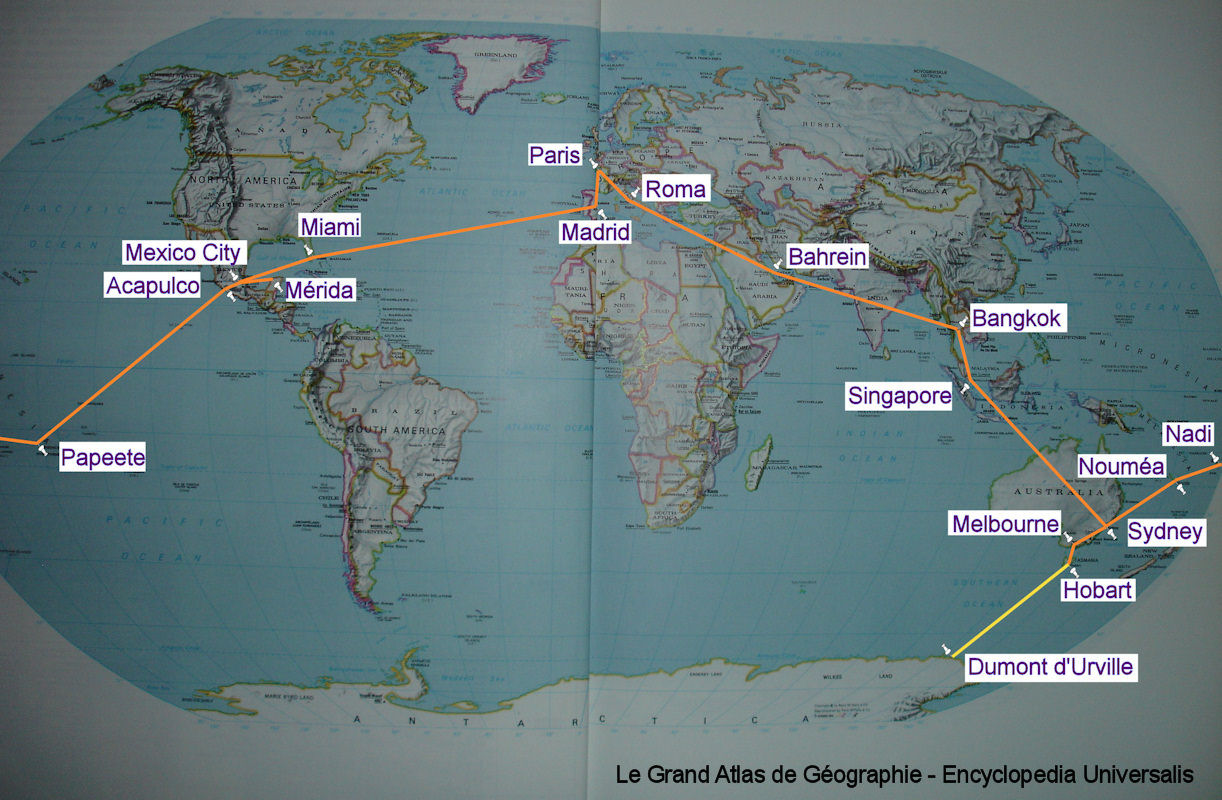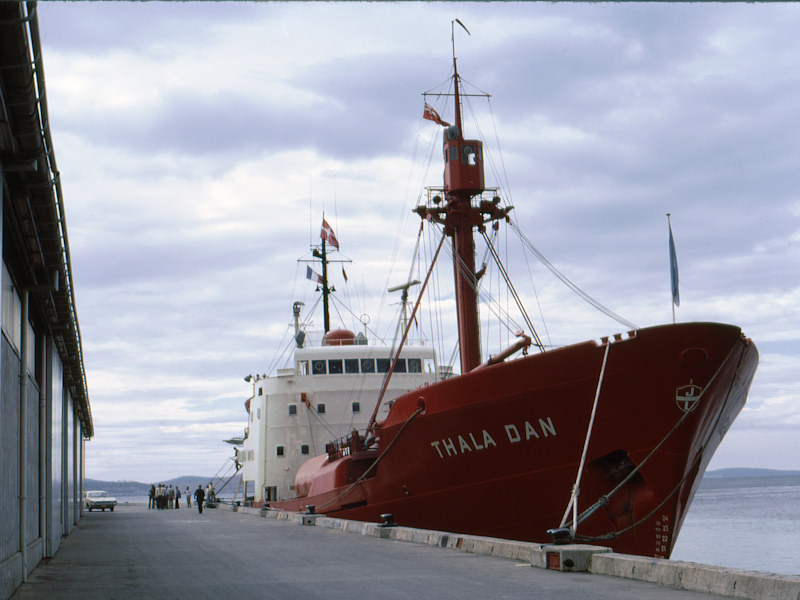Photo
album: "From Paris towards Dumont d'Urville"
Fly
over a photo with the mouse to enlarge it
Click
on a photo to open it in a new window
We
leave Paris Orly on December 1st, 1972 at 10 o'clock but, because of an
unforeseen stop caused by an engine failure of the plane, we'll arrive in
Hobart, Tasmania (Australia), only on Monday December 4th at 8 p.m. Thala Dan
leaves the harbour on Wednesday 6th at 10 a.m. Because of a few technical
problems on the ship we only leave d'Entrecasteaux canal on the morning of the
next day. The sea is rough enough at the beginning of the journey therefore the
progression is slow. On December 15th we travel around looking for big table
icebergs to implant two radio beacons. It is only on the day after that we
arrive in front of a compact enough ice pack, in sight of the continent.
 |
On December 2nd, 1972, a member of
the new IONO team (23rd mission) relaxes, drinking a cup of tea, during the stop in
Bahrain. |
 |
On Friday December 1st, 1972, we
leave Paris, Orly, aboard a Caravelle of Air France that brings us to
Rome. There we embark on a Boeing 747 of the Australian company Qantas
which gets us to Sydney, in Australia, after three stops (Bahrain, Bangkok
and Singapore). Then a Boeing 727 of the ANSETT-ANA transports us to
Melbourne and finally we fly to Hobart in a Douglas DC 9 of TAA. We find
there the Danish polar ship Thala Dan which will bring us to Dumont
d'Urville French base and get us back to Hobart at the end of the sojourn.
I will proceed, then, to my around-the-World trip, visiting New Caledonia and
Mexico before getting back to France. |
 |
It is the first time I'm travelling
in a Boeing 747 and I appreciate the difference with DC 8 or Boeing 707 of
the precedent trips, because the more spaced seat rows let more space to
stretch out our legs and the double aisle allows to move more easily in
the aircraft when we are tired of staying seated. On the contrary, in a
single aisled airplane, the aisle is often obstructed with the flight
attendant's trolleys when they serves drinks or meals. |
 |
We are flying eastwards, that
is meeting the sun, since we have to compensate the ten-hour lag between
Sydney and Paris during the journey the apparent duration of the days is
shorter. As we set up the onboard time before each stop, the times between
two meals is shorter accordingly and we have the feeling we are eating
continuously. In the contrary, when we are flying westwards the apparent
duration of the day exceeds 24 hours and we eat less frequently. |
 |
Two hours after leaving Singapore
the chief pilot announce one of the four jet engines has failed and we
must fly back to Singapore. Two hours later, around midnight, we land and,
after some quick police formalities, a few coaches get us to a comfortable
hotel where we can have a shower and sleep in a bed. This unexpected stop
will last about twenty hours and we will resume our journey the next day
around 7 p.m. |
 |
The next day, after lunch, with
three friends, we negotiate with a taxi driver to drive us around and
visit the town during the afternoon.
The photo shows a banana tree. |
 |
The Tiger Balm Garden gateway. |
 |
A group of young people in the
Tiger Balm Garden. |
 |
A street in the Chinese district.
We don't see much evolution yet compared with my last stay in 1968.
Important changes will occur several years later. |
 |
A lot of sampans are still there in the canal.
|
 |
This man makes his sampan move
ahead pushing a pole against the bottom of the canal. This shows the canal
is not very deep. |
 |
We end our visit in the botanic
garden in the middle of trees pruned in the shape of animals. Then we go
back to the hotel where the coaches take us back to the airport where we
have confirmation the aircraft has been repaired and we can resume the
journey. This unexpected stop after all has been very pleasant because it
cut in two this long voyage and allowed us to rest and to visit Singapore. |
 |
We arrive in Hobart only on Monday
December 4th around 8 p.m., that is 24 hours later that foreseen. We
embark on Thala Dan the very evening but the ship will leave the harbour
on Wednesday 6th around 10 a.m. only. Therefore the next morning we can
linger in the town. The pleasant thing in arriving early December in
Hobart is that it is the cherry and strawberry season. We go to the market place
near the port in order to buy them and fill our bellies with them. |
 |
On Wednesday December 13th, after a
few days of more or less rough sea, we encounter our first ice. |
 |
We pass along an ice floe where two
crabeater seals are resting. These seals stay normally far from the coast
near the edge of the ice pack, however it is possible to see some of them
at the end of winter, on the sea ice, not too far from Dumont d'Urville
base. |
 |
One of the two beacons we have to
install on icebergs. Inside the blue container is the electronic system
that enables to dialog with the satellite of the EOLE programme which will
pick up its position. Inside the wooden box are the high capacity
batteries, they are put into service filling them with water. The metallic
tripod holds the antenna. Each beacon will be firmly anchored on top
of an iceberg. |
 |
During the day of December 15th we
go around looking for two large table icebergs, similar to the one on the
photo, to install, with the help of the helicopter, each one of the
beacons. A beacon of the same type, installed at the end of the last
summer campaign, in March 1972, permitted the satellite EOLE to
pinpoint the iceberg positions during more than a year. The initial scope
of this experiment was to study high altitude atmospheric currents, each
beacon being carried by a long duration drifting balloon. The idea to put
some of those beacons on top of icebergs permits a better knowledge of
marine currents around the Antarctic. The most important part of the
iceberg being situated beneath the ocean surface, its drifting is not
affected by the winds, it depends only on the motion of the
mass of water it is floating in. |
Go
back
.
.
.
.
.
.
.








